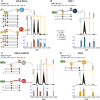Direct histone proteoform profiling of the unannotated, endangered coral Acropora cervicornis
- PMID: 40744498
- PMCID: PMC12311784
- DOI: 10.1093/nar/gkaf740
Direct histone proteoform profiling of the unannotated, endangered coral Acropora cervicornis
Abstract
Epigenetic modifications directly regulate the patterns of gene expression by altering DNA accessibility and chromatin structure. A knowledge gap is presented by the need to directly measure these modifications, especially for unannotated organisms with unknown primary histone sequences. In the present work, we developed and applied a novel workflow for identifying and annotating histone proteoforms directly from mass spectrometry-based measurements for the endangered Caribbean coral Acropora cervicornis. Combining high-accuracy de novo top-down and bottom-up analysis based on tandem liquid chromatography, trapped ion mobility spectrometry, non-ergodic electron-based fragmentation, and high-resolution mass spectrometry, near complete primary sequence (up to 99%) and over 86 post-translational modification annotations were obtained from pull-down histone fractions. In the absence of reliable genome annotations, H2A, H2B, and H4 histone sequences and the annotation of the post-translational modifications of the stressed A. cervicornis coral allow for a better understanding of chromatin remodeling and new strategies for targeting intervention and restoration of endangered reef corals.
© The Author(s) 2025. Published by Oxford University Press.
Conflict of interest statement
The authors declare the following competing financial interest(s): M.K. and D.S. are employees of Bruker Daltonics, manufacturer of the timsTOF Pro 2 and developer of the OSc software.
Figures






Similar articles
-
Combining SDS-PAGE to capillary zone electrophoresis-tandem mass spectrometry for high-resolution top-down proteomics analysis of intact histone proteoforms.Proteomics. 2024 Sep;24(17):e2300650. doi: 10.1002/pmic.202300650. Epub 2024 Jul 17. Proteomics. 2024. PMID: 39018239 Free PMC article.
-
Histone Analysis Using Mobility- and Mass-Selected Ultraviolet Photodissociation in Tandem with Ultra-High-Resolution Mass Spectrometry.Anal Chem. 2025 Jul 8;97(26):13965-13973. doi: 10.1021/acs.analchem.5c02166. Epub 2025 Jun 24. Anal Chem. 2025. PMID: 40552939 Free PMC article.
-
Development of a High-Throughput Platform for Quantitation of Histone Modifications on a New QTOF Instrument.Mol Cell Proteomics. 2025 Jan;24(1):100897. doi: 10.1016/j.mcpro.2024.100897. Epub 2024 Dec 19. Mol Cell Proteomics. 2025. PMID: 39708910 Free PMC article.
-
A narrative review of epigenetic marker in H3K27ac and its emerging potential as a therapeutic target in cancer.Epigenomics. 2025 Mar;17(4):263-279. doi: 10.1080/17501911.2025.2460900. Epub 2025 Feb 21. Epigenomics. 2025. PMID: 39981972 Review.
-
[Epigenetics' implication in autism spectrum disorders: A review].Encephale. 2017 Aug;43(4):374-381. doi: 10.1016/j.encep.2016.07.007. Epub 2016 Sep 28. Encephale. 2017. PMID: 27692350 French.
References
-
- Torda G, Donelson JM, Aranda M et al. Rapid adaptive responses to climate change in corals. Nature Clim Change. 2017; 7:627–36. 10.1038/nclimate3374. - DOI
-
- National Academies of Sciences, Engineering, and Medicine A Research Review of Interventions to Increase the Persistence and Resilience of Coral Reefs. 2019; Washington, DC: The National Academies Press.
-
- Precht W, Bruckner A, Aronson R et al. Endangered acroporid corals of the Caribbean. Coral Reefs. 2002; 21:41–2. 10.1007/s00338-001-0209-2. - DOI
MeSH terms
Substances
Grants and funding
LinkOut - more resources
Full Text Sources
Miscellaneous

